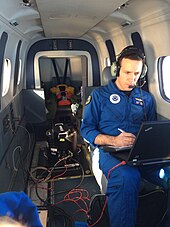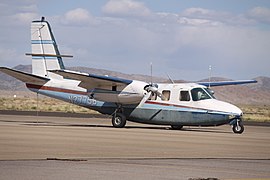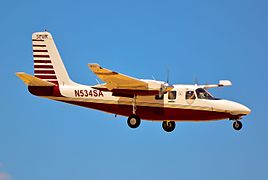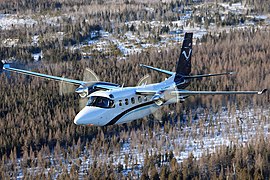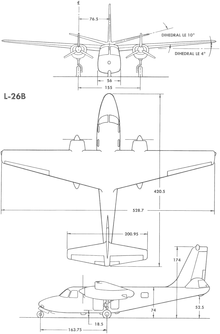
Lycoming Engines is a major American manufacturer of aircraft engines. With a factory in Williamsport, Pennsylvania, Lycoming produces a line of horizontally opposed, air-cooled, four, six and eight-cylinder engines including the only FAA-certified aerobatic and helicopter piston engines on the market.

The Cessna 120,140, and 140A, are single-engine, two-seat, conventional landing gear (tailwheel), light general aviation aircraft that were first produced in 1946, immediately following the end of World War II. Production ended in 1951, and was succeeded in 1959 by the Cessna 150, a similar two-seat trainer which introduced tricycle gear. Combined production of the 120, 140, and 140A was 7,664 units in five years.

Robert Anderson Hoover was an American fighter pilot, test pilot, flight instructor, and record-setting air show aviator.

The Britten-Norman BN-2 Islander is a British light utility aircraft and regional airliner designed and originally manufactured by Britten-Norman of the United Kingdom. Still in production, the Islander is one of the best-selling commercial aircraft types produced in Europe. Although designed in the 1960s, over 750 are still in service with commercial operators around the world. The aircraft is a light transport with over 30 military aviation operators around the world.

The Valmet L-70 Vinka is a Finnish-designed piston-powered military basic trainer aircraft of the 1970s. A production run of 30 aircraft were built for the Finnish Air Force in the early 1980s, and although the type was not exported, it formed the basis of the turboprop-powered Aermacchi M-290 RediGO.

The North American Aviation T-28 Trojan is a radial-engine military trainer aircraft manufactured by North American Aviation and used by the United States Air Force and United States Navy beginning in the 1950s. Besides its use as a trainer, the T-28 was successfully employed as a counter-insurgency aircraft, primarily during the Vietnam War. It has continued in civilian use as an aerobatics and warbird performer.
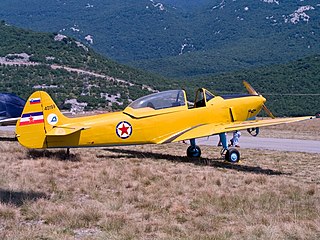
The UTVA Aero 3 was a piston-engined military trainer aircraft built in Yugoslavia to replace the Ikarus Aero 2 then in service. One hundred ten were built, in Yugoslav Air Force service from 1958 to mid-1970s. It was superseded by the UTVA 75.

The Pitts Special is a series of light aerobatic biplanes designed by Curtis Pitts. It has accumulated many competition wins since its first flight in 1944. The Pitts biplanes dominated world aerobatic competition in the 1960s and 1970s and, even today, remain potent competition aircraft in the lower categories.

The Cessna 401 and 402 are a series of 6 to 10 seat, light twin-piston engine aircraft. All seats are easily removable so that the aircraft can be used in an all-cargo configuration. Neither the Cessna 401 nor the 402 were pressurized, nor were they particularly fast for the installed power. Instead, Cessna intended them to be inexpensive to purchase and operate.

The Stinson Reliant is a popular single-engine four- to five-seat high-wing monoplane manufactured by the Stinson Aircraft Division of the Aviation Manufacturing Corporation of Wayne, Michigan.

The Partenavia P.68, now Vulcanair P68, is a light aircraft designed by Luigi Pascale and initially built by Italian company Partenavia. It made its first flight on 25 May 1970, its type certification was granted on 17 November 1971 and was transferred to Vulcanair in 1998. The original six-seat high-wing monoplane is powered by twin piston engines and is used for light transport and training. The P.68 Observer is an observation aircraft variant, and it was developed in a stretched, 10/11-seat twin turboprop derivative.

The Piper PA-31 Navajo is a family of twin-engined utility aircraft designed and built by Piper Aircraft for small cargo and feeder airlines, and as a corporate aircraft. Production ran from 1967 to 1984. It was license-built in a number of Latin American countries.

The Cessna 421 Golden Eagle is an American six or seven seat twin-engined light transport aircraft, developed in the 1960s by Cessna as a pressurized version of the earlier Cessna 411.

The Cessna Model 404 Titan is an American twin-engined, light aircraft built by Cessna Aircraft. It was the company's largest twin piston-engined aircraft at the time of its development in the 1970s. Its US military designation is C-28, and Swedish Air Force designation Tp 87.

The Beechcraft Queen Air is a twin-engined light aircraft produced by Beechcraft in numerous versions from 1960 to 1978. Based upon the Twin Bonanza, with which it shared key components such as wings, engines, and tail surfaces, it had a larger fuselage, and served as the basis for the highly successful King Air series of turboprop aircraft. Its primary uses have been as a private aircraft, utility, and small commuter airliner. Production ran for 17 years.

The Gavilán 358 is a Colombian light utility transport aircraft of the 1990s. A high-winged monoplane powered by a piston engine, small numbers of Gaviláns were produced in the late 1990s/early 2000s, some serving with the Colombian Air Force.

The DINFIA IA 45 Querandi was a 1950s Argentine twin-engined light transport aircraft built by the DINFIA.
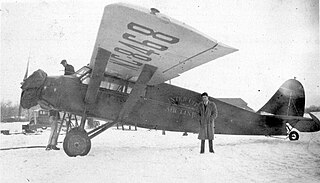
The Stinson Detroiter was a six-seat cabin airliner for passengers or freight designed and built by the Stinson Aircraft Syndicate, later the Stinson Aircraft Corporation. Two distinct designs used the Detroiter name, a biplane and a monoplane.

The Stearman XBT-17 was a prototype 1940s American two-seat low-wing monoplane primary trainer designed and built by Stearman Aircraft. It was evaluated by the United States Army Air Force in 1942 as the XBT-17.

The Stinson Model O was an American single-engined military trainer aircraft of the 1930s designed built by the Stinson Aircraft Company. Based on the Stinson SR, the Model O was designed to meet a requirement of the Honduran Air Force, forming the initial equipment of that air arm.


